Peralta Stones
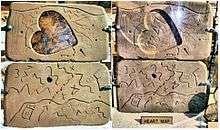
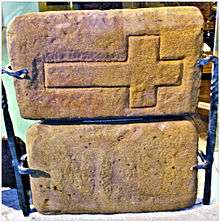
The Peralta Stones are a set of engraved stones. Some people believe they indicate the location of the famed Lost Dutchman's Gold Mine, in Arizona, United States. The Dutchman was a German immigrant named Jacob Waltz.
The stones are named for the Peralta family, said to be an old and powerful Mexican family. Peralta is a common Hispanic surname. Some people named Peralta owned a cattle ranch that included what is now Oakland, California at the time of the Mexican–American War. Pedro de Peralta was the governor of the Spanish territory in New Mexico, and picked the site for Santa Fe. James Reavis popularized the idea of a rich Peralta family in Arizona in 1882, when he tried to assert the phony Peralta Spanish land grant, which included a huge swath of Arizona and New Mexico, including the Superstition Mountains; Reavis' forged Peralta genealogy was exposed, and he served a prison sentence for fraud. According to current legend, but not supported by the historical record, some Peraltas mined in the Superstition Mountains. The first written reference to a “Peralta mine” in the Superstitions was in 1895, by writer Pierpont C. Bicknell.[1]
Description
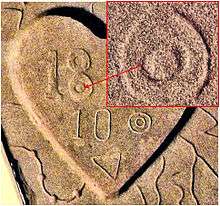
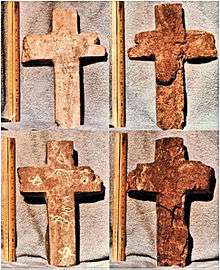
The stones consist of "two red sandstone tablets and a heart-shaped rock made of red quartzite. Each block is approximately 8.25” (~ 21 cm) by 14” (~35.6 cm) and 2” thick, weighing about 25 lbs. Each red stone block is carved with lines and one long line. When the two blocks are placed side by side and the stone heart is inserted the long line has 18 dots pecked into it. This style of map is known as a Post Road Map and it is a style used in Mexico and Spain during the Mexican–American War. Inscribed on the stones is the date 1847, and one stone contains a relief of a heart, which the heart-shaped stone fits perfectly. The heart shape fits neatly in the second stone. The back of the stone that the heart-shaped stone fits into has the outline of a cross carved on the back. The back of the other stone has the word DON carved into it.[2]
There is confusion about the discovery of the Peralta Stones. Some say they were found by a man named "Jack"[3] in 1956[4] (one source says 1952,[1] another 1949[3]) near the main highway that goes from Apache Junction, Arizona,. in the vicinity of Black Point (33°16'19.86"N by 111°19'38.36"W).[2] Another item found at this site is known as the Latin Heart.
The two red sandstone map pieces are displayed with a third white sandstone of similar size and weight as the red ones. The history of the white stone was cited by an author using the moniker ‘Azmula’. Azmula cites the history in the Superstition Mountain Journal, issue 27 of 2009. He attributes the original citation to M. Kraig Roberts. Mr. Roberts’s article is titled “History of the Chain Of Possession Of The Stone Maps”. The Journal article is a history of the white stone. The white sandstone has a side showing a Priest who is assembling the Peralta Stones to form the map. The reverse side is known as the Horse Map. The Priests Stone contains Spanish text that states that to find the gold you must find the heart. The lower half of the number 8 in the red sandstone map has a small heart carved in the circle.[5]
The story of the Peralta Stones' discovery and the stones themselves are not very convincing to most researchers. The engravings appear to have been created using modern power tools, with modern symbols, and modern Spanish.
Father Charles Polzer, an ethnohistorian associated with the Arizona State Museum, is convinced the stones are fakes. Among other reasons, he says that the modern valentine-shaped symbol used to denote a heart was a symbol unknown to 19th-century Spaniards.[6]
Treasure map
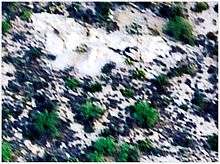

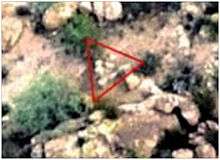


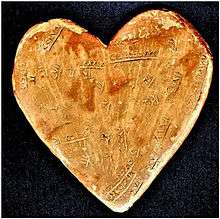
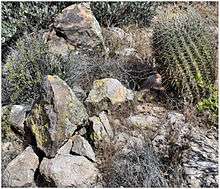

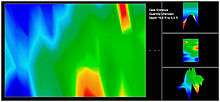
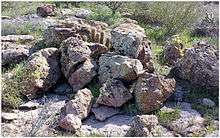
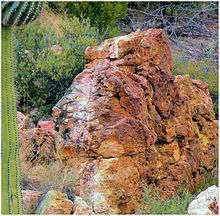
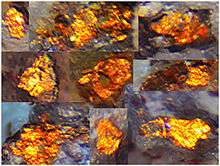


According to local lore, the stones contain a map indicating the location of the Lost Dutchman's Gold Mine. Various claims have been made about the location of the gold mine based on an interpretation of the stones, and such claims appear at regular intervals—though no one has yet recovered a flake of Jacob Waltz's gold.[1]
Claims about interpretations of the map are many, as are accounts of the stones' origins, and most of those claims are made in self-publishing printers.
According to Lon Safko, the stones were made by the Peralta family and handed down for generations.[7]
Danny Adams, in 2005, read the map as a coded message and claims the stones were made by Ted DeGrazia, a painter and art collector rumored to have burned (or buried) a collection of art worth $5 million rather than pay taxes on his property; Adams claims one of the stones reads "Be ready boy, are on a map on Arizona county scale, scale map" and aided by numerological analysis locates the mine in Upper Labarge Canyon. The treasure of paintings, supposedly hidden in the mine, is also connected, somehow, to a conspiracy of 50 businessmen from the Phoenix area to hide DeGrazia's work.[8]
In 2007, William and Michael Johnson (originally from Massachusetts) said that they had identified a privately owned cave as the mine, based on the clues left in the Peralta Stones.[9]
According to Kesselring and Kesselring, the stones are a style of map is known as a Post Road Map, used in Mexico and Spain during the Mexican–American War. They say that the stones are a part of a larger set of Peralta Maps leading to the Treasure of the Church of Santa Fe. They connect the treasure to the Peralta Stones through additional map components. The full set they describe adds two stone crosses and a fired clay heart to the Peralta Stones.[10][11]
The Peralta Stones have some numbers that are believed by some to be a formula for the map scale: that it means that the large hole is 3 km from post 2 and 7 km from post 18. This interpretation would orient the map with the top to the east as was the Burbridge map of 1753 that assigned the Peraltas mines in the Superstition foothills south of the mountains.[12]
The Stone Crosses were found by Mr. Bilbry in a mine shaft on Tortilla Flats in March 1977 at 33°28'43.91"N by 111°22'43.10"W. These crosses fit exactly within the outline of the cross on the red sandstone Peralta block. One cross has another heart carved into it.[13]
The triangle drawn on the Stone Cross was located by the Kesselrings at 33°28'43.91"N, 111°22'43.10"W. They believe that stone cross places the Treasure of the Church of Santa Fe at the location of a heart, and it is the same heart as the hidden heart on the Peralta Stone. The Latin Heart is the detail map of the heart symbol, placing each of 31 caches of bullion within the small heart of the Peralta Stone. It also locates the Peralta mines on the site.[14]
One side of the Latin Heart has a map of terrain features written in Latin. The key to the placement of the Latin Heart into the Peralta Stones is said to be the words ‘Noto Triangulum’ or ‘Notice the Triangle’. The axis of the placement of the Latin Heart within the Peralta Stones is approximated however the Latin Heart also says to look northwest, and near the triangle is a line of stones laid out on the axis of the heart. To adjust for the scale of the Latin Heart map within the Peralta Stones, the arch or ‘Fornix’ was located and used to adjust the scale of the map projection. These elements allow for the approximate location of each of the 31 caches identified in Roman Numerals. A search of the area revealed several types of stone markers thought to identify cache locations. These included what Jacob Waltz, the Dutchman, is said to have referred to as felsenspitze, or spiked stones. Some caches were marked with stone circles in which small hand carved hearts were placed over the caches. The Kesselrings reported GPS coordinates for the 18 posts of the Peralta Stones.[15]
According to the Kesselrings, the buried caches were imaged using a Rover UC, a GPR, revealing metal bars measuring 10” by 5” by ¾”. The bars were reportedly located next to the entrance to the cave supposedly used by the Peraltas to store bullion.[16]
Having found multiple caches of what they interpreted as bullion-shaped nonferrous targets as laid out by the Peralta Stone, the Kesselrings write that they located boulder-covered mines with gold ore at the surface. They report that the Peralta Mine shown on the Latin Heart still has gold ore littering the site, composed of small flakes as observed in the following image.[17]
The aerial photograph is said by the Kesselrings to possibly be the Lost Dutchman Mine. It is located above Cavalry Trail as described by Jacob Waltz and it also looks down on the hidden heart area of the Peralta Stones.[18]
Location
The Peralta Stones were held at the Arizona Museum of Natural History, 53 N. Macdonald, in Mesa, Arizona, previously known as the Mesa Southwest Museum. In June 2009, they were to go on extended display at the Superstition Mountain Museum, 4087 N. Apache Trail,[19][20] in Apache Junction, Arizona.[21][22] As of September, 2012, the stones are once again displayed at the Arizona Museum of Natural History.
Travis E. Tumlinson's Manuscript
In July of 2015, Ryan Gordon acquired the original manuscript written by Travis E. Tumlinson entitled, Challenge For Superstition Gold. The manuscript details Travis' discovery of the Stone Maps, his efforts to decode them and his journey through the Superstition Mountains with family and friends. The manuscript will be printed in multiple different languages and be ready in early 2016.
Palomino Mountain Map
"The ability to read these signs ofttimes depends upon the imagination of the person attempting to do the reading. He must put himself in the place of the person that was hiding the treasure and attempt to think as he did, and at that time."[23]
"The history of treasure symbols is in most part, lost. Most treasure symbols were created out of a need of personal identity and represent strong psychological ties to superstition and religion."[24]
References
- 1 2 3 Hudnall, Ken; Sharon Hudnall (2005). Spirits of the Border IV: The History and Mystery of New Mexico. 4. Omega Press. pp. 43–44. ISBN 978-0-9754923-4-5. Retrieved 30 January 2010.
- 1 2 Kesselring, Robert and Lynda (2013). Reading Peralta Maps :Volume 1, Maps of Stone and Skin (1st ed.). LuLu.com: LuLu Publishing Services. p. 51. ISBN 9781483405339.
- 1 2 Harmon, Katharine (2004). You are here : personal geographies and other maps of the imagination (1st ed.). New York, NY: Princeton Architectural Press. p. 114. ISBN 1568984308.
- ↑ Rawson, Bill (7 August 1985). "Ban on new claims doesn't stop search for Lost Dutchman Gold Mine". The Telegraph (Nashua). p. 44. Retrieved 30 January 2010.
- ↑ Kesselring, Robert and Lynda (2013). Reading Peralta Maps :Volume 1, Maps of Stone and Skin (1st ed.). LuLu.com: LuLu Publishing Services. pp. 53–58. ISBN 9781483405339.
- ↑ Anderson, Craig (7 December 2007). "Brothers stake claim to ‘Lost Dutchman". Metro Phoenix: East Valley Tribune. Archived from the original on 18 December 2007.
...19th-century Spaniards did not represent hearts with the valentine shape used today.
- ↑ Safko, Lon S. (2005). Gratuitous Serendipity: The Right Place, the Right Time. iUniverse. pp. 15–19. ISBN 978-0-595-34186-3.
- ↑ Adams, Danny A. (2005). The Lost Dutchman Lies. Finders Keepers. pp. 27–34.
- ↑ Anderson, J. Craig (7 December 2007). "Brothers stake claim to ‘Lost Dutchman". East Valley Tribune. Archived from the original on December 18, 2007. Retrieved 30 January 2010.
- ↑ Kesselring, Robert and Lynda (2013). Reading Peralta Maps :Volume 1, Maps of Stone and Skin (1st ed.). LuLu.com: LuLu Publishing Services. pp. 1–113. ISBN 9781483405339.
- ↑ Kesselring, Robert and Lynda (2013). Reading Peralta Maps :Volume 2, The Latin Heart (1st ed.). LuLu.com: LuLu Publishing Services. pp. 1–146. ISBN 9781483405353.
- ↑ Kesselring, Robert and Lynda (2013). Reading Peralta Maps :Volume 1, Maps of Stone and Skin (1st ed.). LuLu.com: LuLu Publishing Services. p. 86. ISBN 9781483405339.
- ↑ Kesselring, Robert and Lynda (2013). Reading Peralta Maps :Volume 1, Maps of Stone and Skin (1st ed.). LuLu.com: LuLu Publishing Services. p. 85. ISBN 9781483405339.
- ↑ Kesselring, Robert and Lynda (2013). Reading Peralta Maps :Volume 2, The Latin Heart (1st ed.). LuLu.com: LuLu Publishing Services. p. 75. ISBN 9781483405353.
- ↑ Kesselring, Robert and Lynda (2013). Reading Peralta Maps :Volume 1, Maps of Stone and Skin (1st ed.). LuLu.com: LuLu Publishing Services. p. 82. ISBN 9781483405339.
- ↑ Kesselring, Robert and Lynda (2013). Reading Peralta Maps :Volume 2, The Latin Heart (1st ed.). LuLu.com: LuLu Publishing Services. pp. 115–133. ISBN 9781483405353.
- ↑ Kesselring, Robert and Lynda (2013). Reading Peralta Maps :Volume 2, The Latin Heart (1st ed.). LuLu.com: LuLu Publishing Services. pp. 95–96. ISBN 9781483405353.
- ↑ Kesselring, Robert and Lynda (2013). Reading Peralta Maps :Volume 2, The Latin Heart (1st ed.). LuLu.com: LuLu Publishing Services. p. 106. ISBN 9781483405353.
- ↑ Ward, Greg (2003). The rough guide to Southwest USA. Rough Guides. p. 234. ISBN 978-1-84353-080-0.
- ↑ "Things to Do in Arizona on Saturday, January 5, 2008". Arizona Reporter. 5 January 2008. Retrieved 30 January 2010.
- ↑ Archived April 21, 2013, at the Wayback Machine.
- ↑ http://superstitionmountainmuseum.org/exhibits/the-jacob-waltz-lost-dutchman-exhibit/
- ↑ Wm. Mahan - Early Spanish Treasure Signs & Symbols Page 58
- ↑ Treasure Symbols by Dr. Arnold Kortejarvi
External links
 Media related to Peralta Stones at Wikimedia Commons
Media related to Peralta Stones at Wikimedia Commons- Superstition Mountain museum
- History of the Peralta Stone Maps
- Carbon Dating the Peralta Stone Maps
- An article incredulous about the Peralta Stones